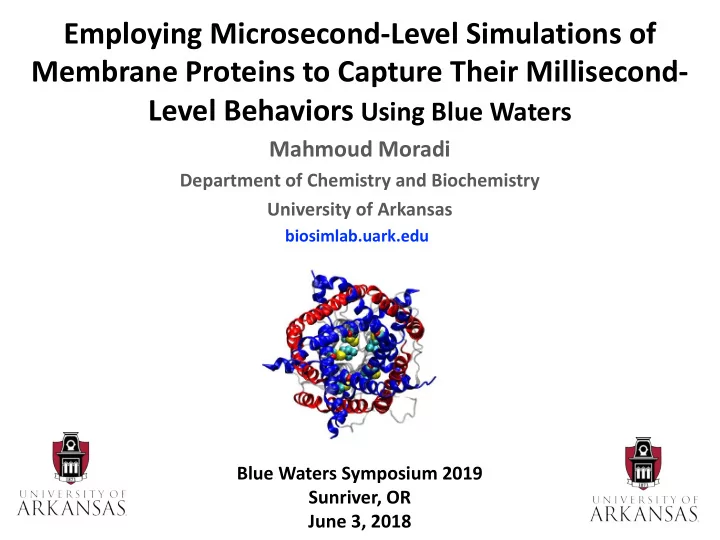

Employing Microsecond-Level Simulations of Membrane Proteins to Capture Their Millisecond- Level Behaviors Using Blue Waters Mahmoud Moradi Department of Chemistry and Biochemistry University of Arkansas biosimlab.uark.edu Blue Waters Symposium 2019 Sunriver, OR June 3, 2018
Outline • Using molecular dynamics (MD) to study protein large-scale conformational changes • Is the so-called unbiased MD reliable? • How can we use biased MD to study large-scale conformational changes? • Developing loosely-coupled multiple-copy (LCMC) MD algorithms within NAMD • Applications to proton-coupled oligopeptide transporter GkPOT and mechanosensitive channel of large conductance MscL
Large-Scale Conformational Changes in Membrane Transport Proteins OF apo IF apo • Membrane transporters rely on out out large-scale conformational changes between inward-facing (IF) and outward-facing (OF) states in in ( alternating access mechanism). out out in in OF bound IF bound • Channels may require large-scale conformational changes between their open/active and closed/inactive states. closed/inactive open/active
Large-Scale Conformational Changes in Membrane Transport Proteins • Membrane transporters rely on large-scale conformational changes between inward-facing (IF) and outward-facing (OF) states ( alternating access mechanism). • Channels may require large-scale conformational changes between their open/active and closed/inactive states.
Large-Scale Conformational Changes in Membrane Transport Proteins • Large-scale conformational changes require concerted motions of thousands of atoms whose motions are coupled by direct or indirect/allosteric interactions. • It typically takes several to thousands of microseconds for a process like those described above to take place. • These conformational changes are typically triggered by certain chemical/mechanical changes in the protein/environment.
Is the so-called unbiased MD reliable? A Case Study: Proton-coupled Oligopeptide Transporters (POTs) S: Substrate OF apo × OF ,H + ,S OF ,H + out + + in × out + + in × IF ,H + IF ,H + ,S IF apo
A Case Study: Proton-coupled Oligopeptide Transporters (POTs) GkPOT (PDB:4IKV, 1.9 Å ) ~100,000 atoms Conventional unbiased MD simulations performed: 8 conditions (different protonation states, substrates) × 400 ns × 2 repeats K Immadisetty, J Hettige, and M Moradi, What Can and Cannot Be Learned from What Can and Cannot Be Learned from Molecular Dynamics Simulations of Bacterial Proton Molecular Dynamics Simulations of Bacterial Proton-Coupled Coupled Oligopeptide Oligopeptide GkPOT? J. Phys. Chem. B, 121 :3644-3656, 2017. Transporter ransporter GkPOT
Monitoring Global Conformational Changes 50 C−,N−Bundle Interdomain Angle(°) Condition 1 UP: apo (Set−1) (Set−2) P:AA (Set−1) Condition 2 P:AA (Set−2) 45 40 N-Bundle C 35 - B u 30 n d l 25 e 20 15 10 Condition 1 UP: apo (Set−1) (Set−2) 28 Condition 2 P:AA (Set−1) P:AA (Set−2) N-,C-Bundle L 4,10 −L 5,11 Distance(Å) Interdomain Angle 25 22 19 16 13 10 0 100 200 300 400 L 4,5 -L 10,11 Distance Time (ns) Time (ns)
Reproducibility Check 50 C−,N−Bundle Interdomain Angle(°) UP: apo (Set−1) UP: apo (Set−2) P:AA (Set−1) P:AA (Set−2) 45 40 35 30 25 20 15 10 UP: apo (Set−1) UP: apo (Set−2) 28 P:AA (Set−1) P:AA (Set−2) L 4,10 −L 5,11 Distance(Å) 25 22 19 16 13 10 0 100 200 300 400 0 100 200 300 400 Time (ns) Time (ns)
Reproducibility Check “Structural basis for dynamic mechanism of proton-coupled symport by the peptide transporter POT.” PNAS 2013 | vol. 110 | no. 28 | 11343–11348. Although a common practice, statements made about millisecond-level biomolecular events based on unbiased sub-microsecond level simulations may not be reliable.
How can we use biased MD to study large-scale conformational changes? Inward-Facing Outward-Facing
Conformational Transition How can we use biased MD to study large-scale Stage1: Path Generation Nonequilibrium Work conformational changes? Empirical Protocol Optimization Simulation Time Collective Variable Stage 2: Path OptIimization Collective Variable Free Energy Stage 3: Path Characterization Reaction Coordinate
Path-Finding Algorithms and Free Energy Calculations Based on Loosely-Coupled Multiple-Copy (LCMC) MD • Path-finding algorithms: e.g., string method (SM or SMwST) – Start from an initial string of N images ( 𝜼 $ ) – Restrain M copies of each image for time ∆𝑢 𝑉 $ 𝝄 = * + 𝑙 𝝄 − 𝜼 $ 2 – Release the restraints and run for time ∆𝑢′ – New string ( 𝜼 $ ) is determined from 𝝄 𝑗 ’s – Iterate until converged • Free energy calculations: e.g., umbrella sampling (US or BEUS): 𝑉 $ 𝝄 = 1 – Bias one or more (e.g., M) copies: 2 𝑙 𝝄 − 𝜼 $ 2 – Use a reweighting scheme to unbias the data: e − β U i ( ξ t ) i = e − β F − β ( U j ( ξ t ) − F j ) ∑ n j e Shirts, Chodera, JCP , 129 , 124105 (2008) j all samples
Riemannian Reformulation • Riemannian reformulation of path-finding algorithms and free energy calculations methods such as SMwST/BEUS provides solutions for the minimum free energy path and its free energy that are invariant under coordinate transformation. • The Riemannian formulation allows for developing more robust free energy calculation methods and path-finding algorithms (due to the “invariance” feature). Fakharzadeh & Moradi, Effective Riemannian diffusion model for conformational dynamics of biomolecular systems . J Phys Chem Lett. 2016;7(24):4980-4987.
Within the LCMC MD scheme, we have developed various improved variations of SMwST/BEUS LCMC MD with NAMD Multiple concurrent NAMD instances are launched with internal partitions of Charm++ and located continuously within a single communication world . Messages between NAMD instances are passed by low-level point-to-point communication functions , which are accessible through NAMD's TCL scripting interface . W. Jiang, J. Phillips, et al. Computer Physics Communications , 185, 908, 2014.
Free Energy along the GKPOT IF-OF Transition Path Free Energy (kcal/mol) Reaction Coordinate
pH-induced Activation of an Engineered Mechanosensitive Channel of Large Conductance (MscL) TM Helices PDB: MD Open Closed 2OAR Model Wild-Type 3 H + H + MscL Tension Induced 1 Opening pH-Dependent Drug Release Engineered MscL Charge Induced 2 Opening Proteoliposome
Adithya Vivek Curtis Dylan Hamid Ugochi Govind Polasa Goolsby Ogden Tabari Isu Kumar
Recommend
More recommend